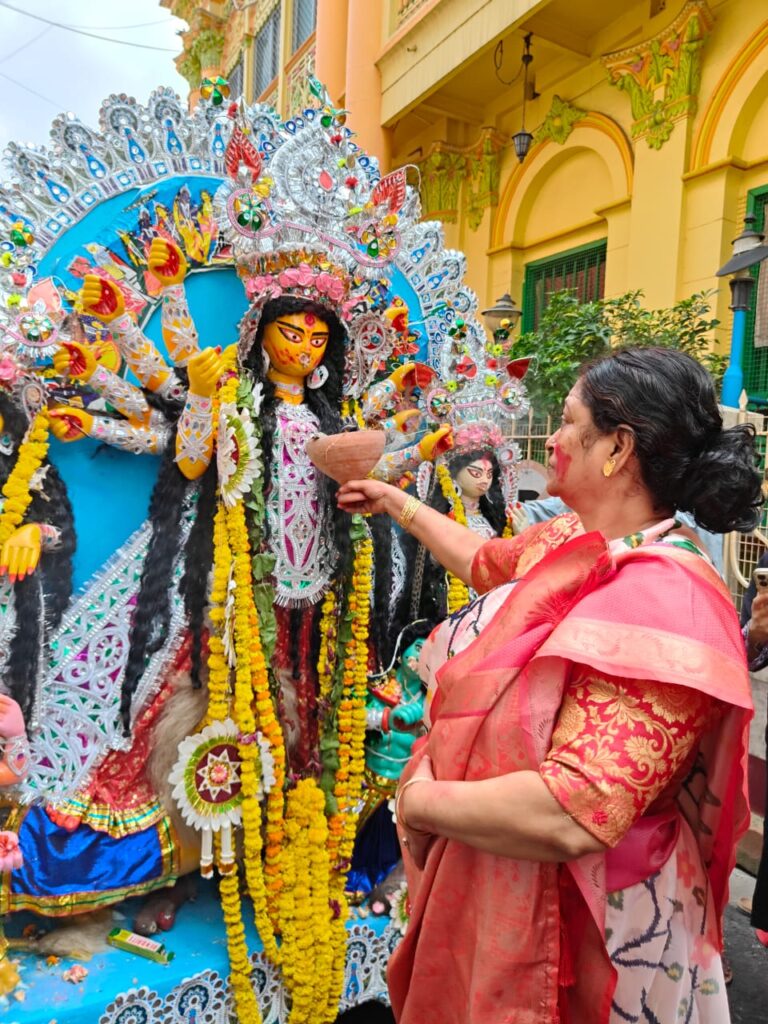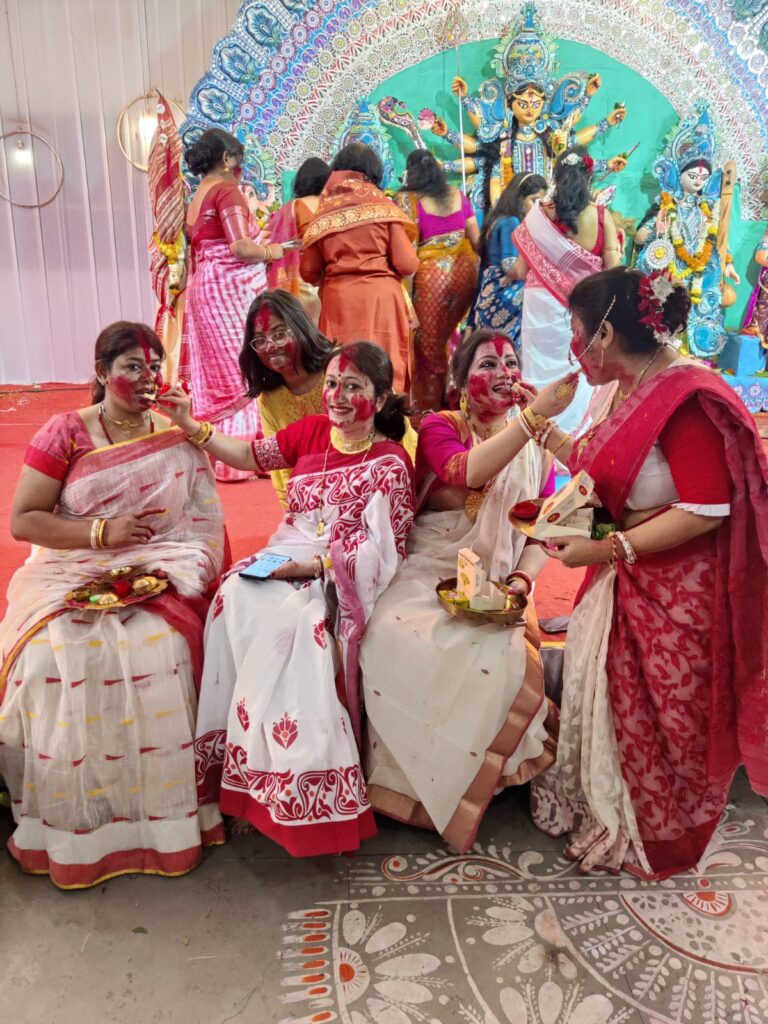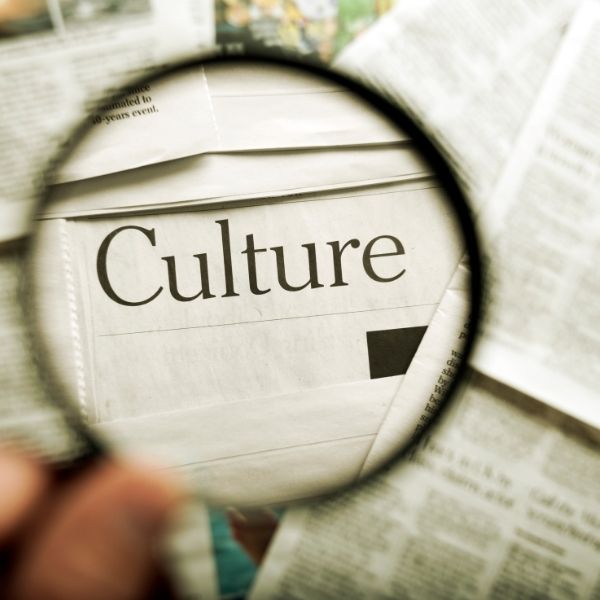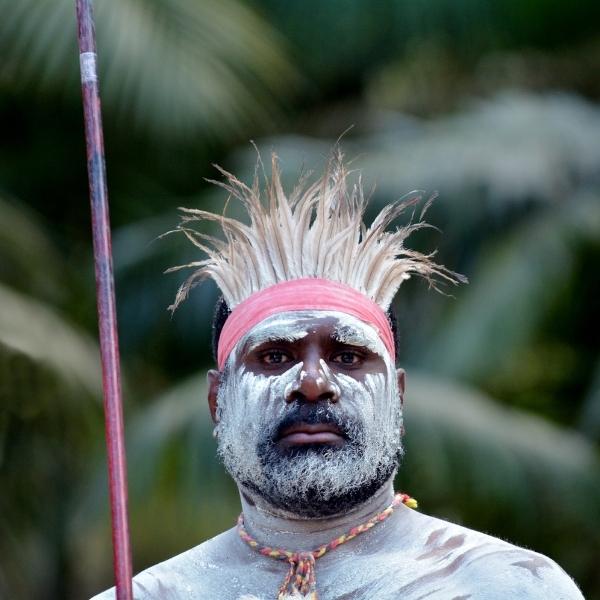Durga puja is one of the biggest festivals of India, especially in Bengal which is located at the eastern part of India. It is not just a religious festival, it represents the rich culture and heritage and celebrated by almost everyone in Bengal irrespective of their cast, creed and religion. Due to its cultural and traditional significance it has declared as one of the Intangible cultural heritages of India.

Fall season in Bengal brings lots of colors, joy and happiness with the celebration of the Bengali’s festival Durga Puja.This is a 10-day long festival to worship Hindu Goddess Durga to celebrate her homecoming after vanquishing the evil power and epitomizes triumph over evil.
Durga puja is not just celebrated in West Bengal, this grand festival is celebrated by all Bengali communities across the globe. It is not just a religious observance, it is a cultural phenomenon that brings together art, tradition, and collective celebration, embodying the rich cultural heritage of Bengal. In 2021, UNESCO added Durga Puja to its Representative List of the Intangible Cultural Heritage of Humanity, further recognizing its significance beyond simply the festivities.
About the origin
As per Indian Mythology , lord Rama started this autumnal Durga Puja also called Akalbodhon. Lord Rama wanted to seek blessings from Devi Durga before starting the battle against Ravan when he abducted Sita. To celebrate the triumph over evil we worship Devi Durga as MahisasuraMardini ( Killer of buffalo-Demon ‘Mahisasura’) by offering 108 blue lotuses and lighting 108 lamps. It is believed , to celebrate her victory against the demons , Devi Durga returns to earth which is believed to be her paternal place, with her four children Ganesha, Kartik, Lakshmi and Saraswati on a vehicle of her choice – elephant, horse, a palanquin or a boat.
This ten-day long festival is usually a grand affair, so it used be celebrated by the elite and affluent houses of Bengal mostly royal families, landlords (known as Zamindars), and all the layman and villagers used to gather there to celebrate the festival together. The first worship of Goddess Durga in Autumn , as per folkloric refences was recorded in the late 1500. Later, from 1700 onwards it started becoming a community affair. In 1790, twelve friends came together to celebrate this festival for the first time, and it stated turning into a community festival instead of just a household puja. Now this festival is celebrated in various association, organization, housing residences, clubs.
What happens in this festival?
During this festival, life-size idols (sometime, much bigger than that) of Devi Durga and her four children are made and kept in a huge temporary bamboo and cloth structures known as ‘Pandals’. This ‘Pandals’ depicts various kinds of artworks which signifies different themes. In these days the city turned into a huge exhibition of art. It is popularly said that the state dresses up like a bride. All the streets are decorated with lights and artwork. Now a days, more than its religious significance, installation of artworks in this Pandals attracts millions of crowds from in and across the country.


(Durga idols in various Pandals of West Bengal, India)
Making of Durga idol
The idols are made from the silt collected from River Ganges over a structure made from bamboo and straw, by various artisans of Calcutta. These artisans live in a particular place known as Kumortuli, and this is their livelihood. These artisans are highly skilled, and they are known and applauded for their handwork. These extremely talented artisans get orders from all over the world for their intricate work. This art of idol making is exclusively seen in this area of Bengal and is one the most upheld cultural heritage of Bengal. The artisans work throughout the year to prepare the exceptionally astounding idols, and this is an attraction for art lovers and tourists from across the globe.
Ma Durga idol has ten arms and in each she has ten different weapons each signifying her strength. It takes months to create one Durga idol and once it is made the last step is painting the eyes which is the final step of idol making. It is believed that the only after painting the eyes on the clay idols, the puja can be started as it brings life to the goddess to the idol.


(Artisan of Kumortuli Busy making Durga idols)
There is no cost applied to see the artwork installations and idols in different pandals and it welcomes crowd from all the background irrespective of their cultural and religious differences. People from all cast, creed, religion and economic backgrounds gather to see the puja pandals. Durga puja has broken the barriers of religion and portrays an epitome of inclusivity.


(Art work installations in Pandals, Kolkata.)
Cultural significance – The Dance, Drum and more
In durga puja some particular kind instruments are being played during offering puja to goddess . Devotees blow conchshells , ring brass bells known as Kansar-Ghanta and play drums. There is a particular type of Drums known as ‘Dhak’ plays in the pandals by the Ritual drummers – “Dhakis” .

(A Dhaki playing Dhak in a puja pandal)
Moreover, Bengalis also offer a particular dance performance to the goddess during the worship known as Dhunuchi Dance. Bengali ladies dance in Bengal’s famous traditional red bordered white sarees and men in traditional Bengali men attire Dhoti Panjabi with an earthen pot in hand filled with burning coconut husk, camphor and Dhuno (an Indian form of Frankincense). Balancing this burning pot while dancing is an unique sight to behold.
Many Bollywood movies like Parineeta’ , ‘Devdas’ (both of them are adaptation of Bengali novel by Sarat Chandra Chattopadhyay) , ‘Kahaani’, depict these scenes and show the essence of this unique festival of Bengal.

(Durga puja shown in various Bollywood movies– Image source – Filmfare.com htt ps://www.filmfare.com/features/durga-puja-in-bollywood-4366.html)
UNESCO Intangible Cultural Heritage
Durga puja was listed as UNESCO Intangible Cultural Heritage of Humanity in 2021 for its uniqueness. As observed by UNESCO, during this festival the division of class, religion and ethnicities collapse as crowds of spectators walk around to admire the installations. UNESCO refers it as referred as the world’s biggest public art festival — is a unique event that mixes tradition with trend and faith with fun & frolic and touches the lives of millions of people.
Since the household puja turned into community puja, this festival has become a celebration of life transmitted from one generation to another, year after year.
The rituals
It is a ten day festival. Mahalaya marks the start of Devi paksha the inaugural day of the festival. The puja usually starts from the sixth day and continues for four consecutive days. During these five days period various religious rituals are being performed including Pushpanjali, Kumari Puja, Sandhi Puja, Offerings of 108 lotuses and 108 earthen lamps to the goddess,
The festival ends on the tenth day, when the goddess is immersed in the holy river Ganges.
In the 10th day of the puja, which marks the end day of the festival , married Bengali women wear traditional Bengali red and white saree and bid goodbye to the goddess with sweets and vermillion. They put vermillion to each other’s face and this practise is referred to as ‘sindur ( vermillion) khela’ and offer sweets to each other before the immersion of the goddess.


(The end day rituals – Thakur Boron, Dhunuchi naach, Sindur Khela)
Thereafter the idol got immersed in the holy water of river Ganges from where the clay was initially taken. The immersion signifies the departure of the Goddess from earth to the heaven again. The whole Bengal bids goodbye to the goddess with heavy hearts and countdown for next year’s Durga puja begins.
This is how this days long festival celebrated in Bengal. From its essence and elements we can clearly see why Durga puja is not just a religious festival of Bengal, but a celebration of art, culture, tradition, customs and heritage which has turned it into a world heritage.
(Images taken – Sucharita Ghosh)





